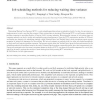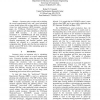26 search results - page 1 / 6 » Job scheduling methods for reducing waiting time variance |
COR
2007
13 years 4 months ago
2007
Minimizing Waiting Time Variance (WTV) is a job scheduling problem where we schedule a batch of n jobs, for servicing on a single resource, in such a way that the variance of thei...
HPDC
2009
IEEE
13 years 11 months ago
2009
IEEE
Large-scale distributed computing systems such as grids are serving a growing number of scientists. These environments bring about not only the advantages of an economy of scale, ...
ICPADS
2006
IEEE
13 years 11 months ago
2006
IEEE
Multi-cluster schedulers can dramatically improve average job turn-around time performance by making use of fragmented node resources available throughout the grid. By carefully m...
ICRA
1999
IEEE
13 years 9 months ago
1999
IEEE
Inventory plays a major role in deciding the overall manufacturing costs, and a good scheduling system should balance the on-time delivery of products versus low work-in-process (W...
CLOUDCOM
2010
Springer
13 years 2 months ago
2010
Springer
Inspired by Darwinian evolution, a genetic algorithm (GA) approach is one of the popular heuristic methods for solving hard problems, such as the Job Shop Scheduling Problem (JSSP...


